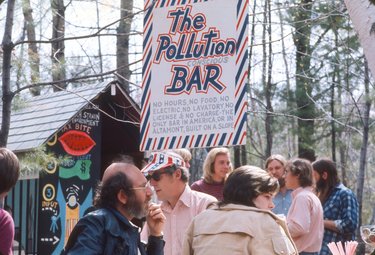Cowley’s son and namesake preserves the legacy. Remembering Altamont’s most famous artist — and activist
To the Editor:
There hangs in my dad’s closet a red and white striped, long-sleeved “bartender’s” dress shirt that has not been worn in nearly 50 years. My father was then in charge of the “Pollution Bar,” the center of activity at his outdoor art shows many long years ago.
Assisted by his two young sons, we all wore the same striped shirts.Serving only draft beer, the Pollution (conscious) Bar had: “no hours, no food, no lavatory, no license & no charge — the only bar in America, or in Altamont, built on a slope.”
The outdoor art, freshly painted on half-inch plywood panels was as contemporary as contemporary art ever could be, expressing my father’s politics, humor, interest,s and vitally important themes of concerns as relevant today as back then. The independent rebel within also wanted “to put art on a basis of a 24-hour day, 7 days a week in defiance of all unions, academies, galleries, museums and even amusement parks.”
During Edward P. Cowley Jr.’s tenure as chairman of the art department at the local university and under his auspices and guidance, he made available an underused storage office room that became the center of the “Protect Your Environment” movement, known as PYE, in the Capitol District.
Led by Lou Ismay, the “Environmental Forum” was a first-of-its-kind study course for academic credit on a broad range of environmental issues. This small office in the Art building was the hub and incubator in all directions of various activities, businesses, and organizations, such as the “Save the Pine Bush” movement, and it supported initiatives like the sloop Clearwater mission to end pollution of the Hudson River.
As a University at Albany student in the late sixties and early seventies, I observed these developments firsthand and was a participant. This second-floor office opened early and buzzed all day with activity well into the wee hours, seven days a week. A pot of coffee was always on.
The degree of student interest, enthusiasm, and dedicated participation was unlike anything I have ever seen. Additionally, my dad contributed to the movement with his unique outdoor shows, featuring environment-friendly themes.
One year, a bus brought Albany students to the hillside show behind our house on Township Road. The only problem was this diesel bus could not be turned off and spewed continuously a wretched, foul-smelling exhaust cloud.
I never saw my dad so incensed and despicably mad. The letter that followed to the United Traction Company expressed “shock” and “dismay” and spoke of criminal “environmental abuse.” I felt sorry for the bus driver. Though wounded, he did survive.

I always wondered why my dad stopped doing the outdoor shows. By 1972, I believe he felt much better about the improved awareness and concern for environmental issues by so many more folks. The movement was well underway and mainstream. Besides, preparing for the outdoor shows took a tremendous amount his time.
He just wanted to focus again on his art — exploring pastels more, a lot less oils and a lot more stained glass. He just moved on or possibly just back to what he used to do after a seven-year hiatus.
Unlike his well-known oil paintings of Altamont architectural landscapes, few of the outdoor paintings survived. Paintings not sold were artfully recycled into bus-stop shelters, garden sheds, and other construction projects.
The family now has fewer than a half-dozen of over 250 originals. Some newspaper articles were written. Only a few quality color photos have I found — that is until last week.

On one of our recent snow days, while waiting for my friend Dave V. to plow us out, I discovered in deep storage a cache of colored slides mixed in with thousands of the “the others.” I decided to process them at where it’s happening and create an archive.
In just a few more years, the “veterans” of the outdoor shows will be gone but now there will be a record passed on to the next generations as they face the same issues anew.

So I ask anyone who attended any of the six outdoors shows to share any personal anecdotes, pictures, or memories and contact me: [email protected] or phone (518) 861-6915. And if you have a painted piece of plywood that looks a bit unusual with an activist message, by all means give me a call.

Ed Cowley III
Altamont
